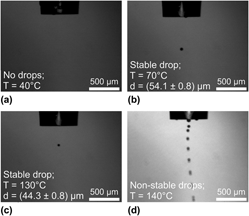Article contents
Microdrop generation and deposition of ionic liquids
Published online by Cambridge University Press: 22 July 2014
Abstract

This work describes the use of a piezo-actuated inkjet print head with a nozzle aperture of 50 µm to obtain picoliter drops of different model ionic liquids (ILs). A theoretical analysis of the microdrop generation of three model ILs is confirmed by experiments. The inkjet print process was optimized to enable a stable and reproducible drop ejection in both continuous and drop-on-demand modes by controlling the temperature of the nozzle, as well as the electrical signal sent to the piezo actuator used to generate the drops. Controlled volumes ranging from 43 ± 3 pL to 319 ± 1 pL have been achieved, with a volume control down to 3 pL. The null volatility of ILs yields an extremely high stability of the inkjet process, obtaining drops with very constant volumes during the entire print process. It also avoids the coffee staining effect observed in the deposition of conventional liquid drops. The possibility to deposit controlled volumes in a reproducible way is demonstrated here and applied to a proof-of-concept application with the aim to create dense concave optical lens arrays by replicating the deposited ionic liquid microdrops in poly(dimethylsiloxane) (PDMS).
- Type
- Articles
- Information
- Journal of Materials Research , Volume 29 , Issue 17: Focus Issue: The Materials Science of Additive Manufacturing , 14 September 2014 , pp. 2100 - 2107
- Copyright
- Copyright © Materials Research Society 2014
References
REFERENCES
- 6
- Cited by


